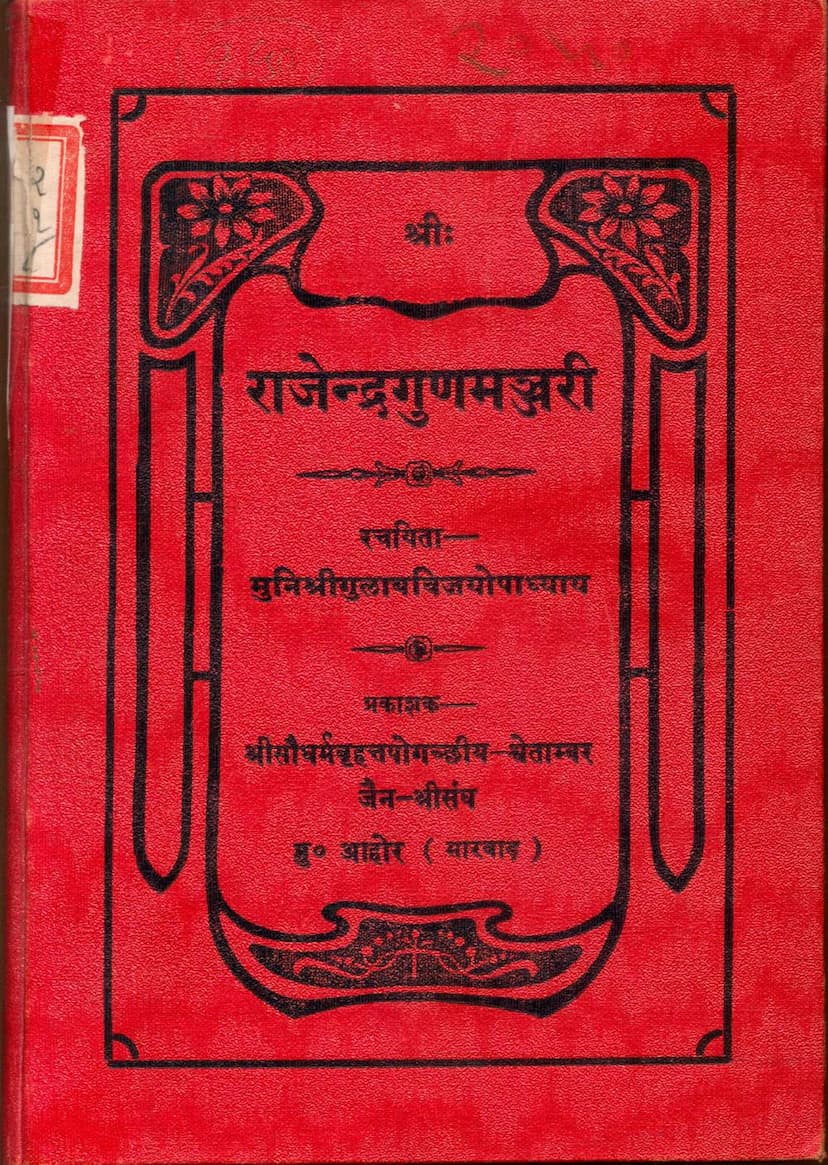Rajendra Gun Manjari
Added to library: September 2, 2025

Summary
Here's a comprehensive summary of the Jain text "Rajendra Gun Manjari" by Munishri Gulabvijay, based on the provided pages:
Overall Purpose and Context:
"Rajendra Gun Manjari" is a devotional and biographical work that celebrates the life and teachings of Acharya Shrimad Vijay Rajendra Surishwarji Maharaj. The text aims to highlight his significant contributions to Jainism, particularly his efforts in restoring and upholding righteous conduct (kriyauddhar) and his profound spiritual and scholarly achievements. The book is dedicated to the welfare and spiritual upliftment of the Jain community.
Key Figures and Lineage:
The book is presented under the patronage of the Saudharm Brihat Tapagacchiya Shwetambar Jain Sangh. It extensively praises and acknowledges the spiritual lineage and contributions of several prominent Jain Acharyas, including:
- Shrimad Vijay Rajendra Surishwarji Maharaj: The central figure of the book, revered for his multifaceted accomplishments.
- Shrimad Vijay Dhanchandra Surishwarji: A significant successor and guide.
- Shrimad Vijay Bhupendra Surishwarji: Another revered Acharya involved in the book's editing and guidance.
- Shrimad Vijay Yatindra Surishwarji: A contemporary Acharya also acknowledged for his contributions.
- Munishri Gulabvijay: The author, who meticulously compiles the life and deeds of Acharya Rajendra Surishwarji.
Content Overview (Based on the "Vishayanukram" - Table of Contents):
The book is structured into several sections, covering various aspects of Acharya Rajendra Surishwarji's life, teachings, and the historical context of Jainism during his time.
Biographical Narrative of Acharya Rajendra Surishwarji:
The text details Acharya Rajendra Surishwarji's life from his birth and early life to his spiritual journey and eventual ascendance to divine realms. Key events and aspects covered include:
- Early Life and Virtues: His birth into the Parikh clan, his early inclination towards spiritual pursuits, and his inherent virtuous qualities.
- Spiritual Journey: His journey to Singhaldwip (Sri Lanka), his separation from his parents, his renunciation of worldly life, and his initiation into the monastic order under the guidance of Acharya Pramod Suri.
- Scholarly Pursuits and Ordination: His rigorous study of Jain scriptures, his major initiation (Brihat Diksha), and his attainment of the title of "Panyas."
- Upholding Jain Principles: His role in addressing doctrinal disputes, accepting and enforcing strict vows (purnabhigraha), and his commitment to the correct interpretation and practice of Jainism.
- Preaching and Social Reforms: His extensive travels, his efforts to guide and uplift countless individuals towards right faith (samyaktva), his establishment of Jain temples and knowledge repositories (gyanbhandars), and his authorship of significant Jain literature like "Abhidhan Rajendra Kosh." He is credited with reviving lost traditions and combating laxity in religious practices.
- Asceticism and Austerities: Descriptions of his severe penances and ascetic practices, highlighting his detachment and spiritual fortitude.
- Miraculous Powers and Influence: The text hints at his extraordinary abilities and the profound impact he had on the spiritual and social landscape.
- His Passing and Legacy: His final days, his peaceful demise, and the establishment of his idol for veneration.
- Guru Parampara: The book includes genealogies of his gurus and predecessors, emphasizing the continuity of the spiritual tradition.
Key Themes and Teachings:
- Importance of Righteous Conduct: A strong emphasis is placed on adhering to the strict principles of Jainism, as advocated by the ancient Acharyas.
- Spiritual Detachment: The narrative underscores the necessity of renouncing worldly attachments for spiritual liberation.
- Knowledge and Practice: The book highlights the integration of scholarly knowledge (gyan) and righteous practice (kriya) as essential for spiritual progress.
- Devotion and Reverence: The text is replete with devotional praise for the Acharyas, encouraging similar reverence among readers.
- Social Harmony and Reform: Acharya Rajendra Surishwarji's efforts to resolve community conflicts and promote ethical behavior are noted.
- The Power of Penance and Austerity: The effectiveness of tapasya in purifying the soul and achieving spiritual goals is a recurring theme.
- The Impermanence of Worldly Life: The book frequently reminds readers of the transient nature of life and material possessions, urging them to focus on spiritual welfare.
Literary Style and Structure:
The "Rajendra Gun Manjari" is written in a devotional and narrative style, incorporating verses and prose to recount the life and teachings of the revered Acharya. The inclusion of Sanskrit and Hindi prefatory statements and the detailed table of contents suggest a well-organized and comprehensive approach to its subject matter. The "Guna Ashtakam" sections are poetic tributes to the spiritual masters.
Significance of the Book:
This work serves as a valuable historical and spiritual document for the Jain community, particularly for followers of the Tapagachha tradition. It offers insights into the life of a significant Jain luminary, his teachings, and the spiritual practices that were prevalent during his era. It aims to inspire readers to follow the path of righteousness and devotion.